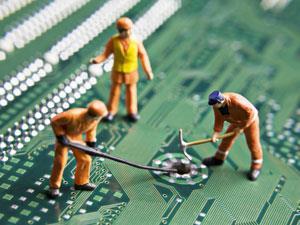Chinese researchers have developed a simple and environmentally friendly method to salvage the materials found in waste printed circuits boards (PCBs) using the solvent dimethyl sulfoxide (DMSO). The team says it could be part of the solution for the 20–50 million tonnes of e-waste that's generated globally every year, much of which ends up in developing countries, including China.
PCBs are found in virtually every electronic device and are multi-layered structures composed of around 30% metal and 70% non-metal polymers. Many contain brominated epoxy resins which are used as flame retardants. Since the layers are tightly bonded together, eco-friendly ways of recycling PCB materials has remained a challenge.

Separation methods to recover the precious metals from waste PCBs do exist, including hydrometallurgical processes combined with pyrolysis, which use aqueous solvents such as strong acids and alkalis. However, these processes contaminate the environment with toxic heavy metals and persistent organic pollutants and generate huge amounts of spent acids that cannot be recovered.
Now, Ping Zhu and colleagues at Zhejiang Gongshang University, Hangzhou, have come up with a simple separation process which they say could recover valuable materials from waste PCBs while driving down recycling costs and avoiding environmental pollution caused by other methods.
'Other methods separate waste PCBs by decomposing the polymer resin, which can generate highly toxic polybrominated dibenzodioxins and dibenzofurans,' says Zhu. 'In our process, the polymer resin is swelled not decomposed into the solution and the solvent can be reused, so the process has no secondary pollution and the operation is simple and easy.'
First, the team manually remove the electronic components on waste PCBs and cut the remaining bare boards into fragments of approximately 1–1.5cm2 or 2–3cm2. Then, under a nitrogen atmosphere, the fragments are heated with DMSO. The DMSO swells the brominated epoxy resin, which separates the PCB layers. The solution is then filtered and separated, and the used DMSO is regenerated by evaporation under vacuum to leave the separated polymer resin and the circuit board components.
'This is genuinely a breakthrough in waste PCB recycling processes,' says Saeed Nusri, a chemical engineer at Ecyclex, an e-waste management company in the United Arab Emirates. 'This study remarkably solves a lot of issues of solvent recovery and process complexity which are generally faced in hydrometallurgy pertaining to PCB recycling. With only 2% loss of DMSO in every run, a lot can be saved on the raw materials.'
However, Nusri has concerns about scaling the process up. 'The size [of the PCB fragments] seems to be an important factor in determining the mass transfer rate of DMSO to the brominated epoxy resins.' Nusri explains. 'An increase of approximately 1cm2 drastically affected the diffusion rate of the solvent into the pieces. This, in my opinion, could be an issue on an industrial scale.'
References
P Zhu et al, Environ. Sci. Technol., 2013, DOI:10.1021/es303264c






No comments yet